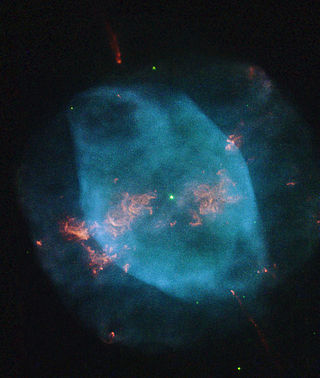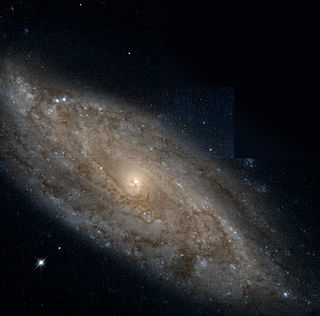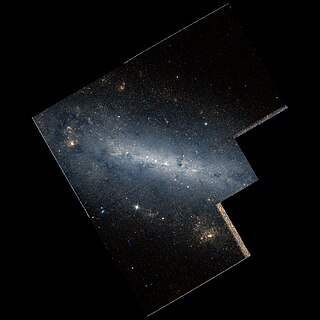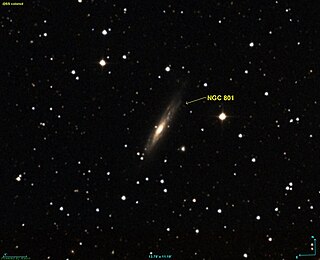
GK Persei was a bright nova first observed on Earth in 1901. It was discovered by Thomas David Anderson, an Edinburgh clergyman, at 02:40 UT on 22 February 1901 when it was at magnitude 2.7. It reached a maximum magnitude of 0.2, the brightest nova of modern times until Nova Aquilae 1918. After fading into obscurity at about magnitude 12 to 13 during the early 20th century, GK Persei began displaying infrequent outbursts of 2 to 3 magnitudes. Since about 1980, these outbursts have become quite regular, typically lasting about two months and occurring about every three years. Thus, GK Persei seems to have changed from a classical nova like Nova Aquilae 1918 to something resembling a typical dwarf nova-type cataclysmic variable star.
Gliese 674(GJ 674) is a small red dwarf star with an exoplanetary companion in the southern constellation of Ara. It is too faint to be visible to the naked eye, having an apparent visual magnitude of 9.38 and an absolute magnitude of 11.09. The system is located at a distance of 14.8 light-years from the Sun based on parallax measurements, but is drifting closer with a radial velocity of −2.9 km/s. It is a candidate member of the 200 million year old Castor stream of co-moving stars.

Eta Arietis, Latinized from η Arietis, is the Bayer designation for a star in the northern constellation of Aries. It is dimly visible to the naked eye with an apparent visual magnitude of 5.231. With an annual parallax shift of 33.34 mas, the distance to this star is approximately 97.8 light-years. It is drifting further away with a radial velocity of +4.5 km/s.

Lambda Centauri, Latinized from λ Centauri, is a star in the southern circumpolar constellation of Centaurus. It has an apparent visual magnitude of +3.13, which is bright enough to be seen with the naked eye from the Southern Hemisphere and places it among the brighter members of this constellation. The star is close enough that its distance can be determined directly using the parallax technique, which gives a value of approximately 470 light-years from the Sun. Although a putative solitary star, it has a candidate proper motion companion at an angular separation of 0.73 arcseconds along a position angle of 135°. The nebula IC 2944 lies nearby.

NGC 7354 is a planetary nebula located in the northern circumpolar constellation of Cepheus, at a distance of approximately 5.5 kly from the Sun. It was discovered by German-born astronomer William Herschel on November 3, 1787. John L. E. Dreyer described it as, "a planetary nebula, bright, small, round, pretty gradually a very little brighter middle".

NGC 7314 is a spiral galaxy located in the southern constellation of Piscis Austrinus. It was discovered by English astronomer John Herschel on July 29, 1834. This is a nearby Seyfert (active) galaxy, located at a distance of approximately 54.6 megalight-years from the Milky Way. Since it appears to have detached spiral arm segments, it was listed in Halton Arp's Atlas of Peculiar Galaxies.
Gliese 412 is a pair of stars that share a common proper motion through space and are thought to form a binary star system. The pair have an angular separation of 31.4″ at a position angle of 126.1°. They are located 15.8 light-years distant from the Sun in the constellation Ursa Major. Both components are relatively dim red dwarf stars.
IC 1838 is a spiral galaxy of type Sc. It lies in the Taurus constellation, 471 million light years away from Earth. It has a diameter of 13,046.5 light years and a thickness of 1,304.7 light years.
GJ 3379 is the nearest star in the Orion constellation, located at a distance of 17 light years from the Sun based on parallax. It is a single star with an apparent visual magnitude of +11.31 and an absolute magnitude of +12.71, therefore, the star is not visible with the naked eye. It is positioned in the upper left part of the Orion constellation, to the SSE of Betelgeuse. This star is drifting further away with a radial velocity of +30.0 kilometers per second. In the past, this star had a relatively close encounter with the Solar System. Some 161,000±6,000 years ago, it achieved a minimum distance of 4.08 ± 0.20 ly (1.25 ± 0.06 pc).
HIP 12961 is a star with an exoplanetary companion in the equatorial constellation of Eridanus. It is too faint to be visible to the naked eye, with an apparent visual magnitude of 10.24. The distance to this system can be estimated from its parallax measurements, which yield a separation of 76.3 light-years from the Sun. It is receding with a radial velocity of +33 km/s and has a high proper motion, traversing the celestial sphere at an angular rate of 0.300″ yr−1.
HD 79498 is a primary of the star system located 159 light years away in the constellation Cancer. This G5 main sequence star has an apparent magnitude of 8.0 and is about the same size and mass as the Sun. It has a higher than solar abundance of elements other than hydrogen and helium; what astronomers term a metal-rich star.
μ Cygni, Latinised as Mu Cygni, is a binary star system in the northern constellation of Cygnus. It is visible to the naked eye as a faint point of light with a combined apparent visual magnitude of 4.49. The system is located 72 light years distant from the Sun, based on parallax, and is drifting further away with a radial velocity of +17 km/s.
EQ Pegasi is a nearby binary system of two red dwarfs. Both components are flare stars, with spectral types of M4Ve and M6Ve respectively, and a current separation between the components of 5.8 arcseconds. The system is at a distance of 20.4 light-years, and is 950 million years old. The primary star is orbited by one known exoplanet.
GJ 625 is a small red dwarf star with an exoplanetary companion in the northern constellation of Draco. The system is located at a distance of 21.1 light-years from the Sun based on parallax, but is drifting closer with a radial velocity of −13 km/s. It is too faint to be visible to the naked eye, having an apparent visual magnitude of 10.13 and an absolute magnitude of 11.06.

NGC 672 is a spiral galaxy in the northern constellation of Triangulum, positioned around 2° to the southwest of the star Alpha Trianguli. The original object designated NGC 672 was discovered by the German-born astronomer William Herschel on 26 October 1786, but this was later cataloged as NGC 614. The object now identified as NGC 672 was discovered by John Herschel on 11 November 1827.

NGC 801 is a spiral galaxy with an active galaxy core in the constellation Andromeda. It is estimated to be 174 million light-years from the Milky Way and has a diameter of approximately 174,400 light-years. The object was discovered on September 20, 1885 by the American astronomer Lewis A. Swift.

NGC 1325 is a flocculent spiral galaxy situated in the constellation of Eridanus. Located about 75 million light years away, it is a member of the Eridanus cluster of galaxies, a cluster of about 200 galaxies. It was discovered by William Herschel on 19 December 1799.

HD 203030 is a single, yellow-orange hued star with a sub-stellar companion in the northern constellation of Vulpecula. The designation HD 203030 is from the Henry Draper Catalogue, which is based on spectral classifications made between 1911 and 1915 by Annie Jump Cannon and her co-workers, and was published between 1918 and 1924. This star is invisible to the naked eye, having an apparent visual magnitude of 8.45. It is located at a distance of 128 light years from the Sun based on parallax, and is drifting closer with a radial velocity of −17 km/s.

NGC 5533 is an unbarred spiral galaxy in the constellation Boötes. It was discovered by the astronomer William Herschel on May 1, 1785. It has a regular structure, with one tightly wound spiral; its disk is inclined about 53 degrees towards the line of sight.

HD 53367 is a triple star system in the constellation of Monoceros. The primary star was identified as a variable Herbig Ae/Be star in 1989. Its companion, spectroscopically discovered in 2006, is a pre-main-sequence star star with an average separation of 1.7 AU. The star system is embedded in the extended nebula IC 2177.











